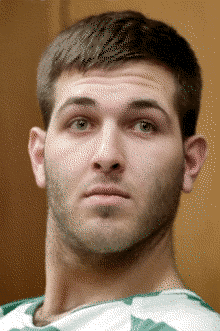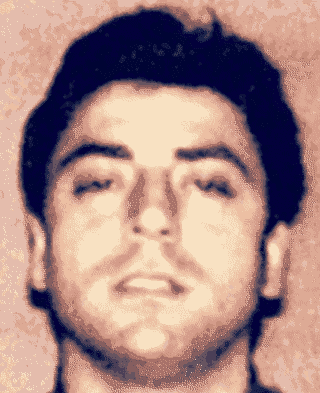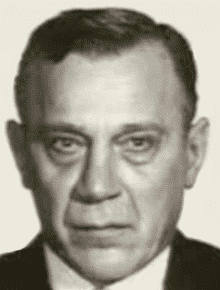This article was originally published on March 13, 2019, with updates later in 2019 and in 2025, and a substantial rewrite on March 13, 2021.
Listen to this article:

Comello
The March 13, 2019, killing of a reputed New York crime boss was attributed to a follower of the QAnon movement, who reportedly believed he was acting in the interest of then-President Donald Trump. The trial of Anthony Comello of Staten Island on charges of murder and criminal weapon possession was put off indefinitely in June 2020, as New York State Justice William E. Garnett found Comello mentally unfit to stand trial and ordered him to a mental health facility.
Update: Early in 2025, the Staten Island Advance obtained court documents indicating that Comello pleaded guilty to manslaughter in private proceedings and was sentenced to an undisclosed prison term at an undisclosed location. Secrecy in the matter was justified by the danger of underworld retribution.
Francesco Cali, known to law enforcement as the boss of the New York-based Gambino Crime Family, apparently was drawn out of his Todt Hill, Staten Island, home and fatally shot at about nine o'clock Wednesday evening, March 13.
In early reports, the news media speculated that the killing might signal a new factional conflict within the Gambino organization. There also were suggestions that the killing sprang from a racket-related dispute or a personal matter. Nine months later, the killing's bizarre political connections were revealed in a court document submitted by Comello's defense attorney. The decision to send the defendant to a mental health facility followed in early June 2020.
The investigation
Shortly after nine o'clock on March 13, 2019, emergency dispatchers received a 9-1-1 call from No. 25 Hilltop Terrace off Four Corners Road in the Todt Hill section. Fire department medics and police responded. They found Cali, fifty-three, had suffered multiple gunshot wounds.
They rushed Cali to the North Campus of Staten Island University Hospital, about a mile and a half away at Seaview and Mason Avenues. He was pronounced dead at the hospital.
According to published accounts, no one in the generally quiet residential neighborhood saw the shooting. Several residents reported hearing a series of six or seven gunshots just after nine o'clock. One resident said those were followed by a pause and then several more shots.
A blue pickup truck was observed leaving the area immediately after the shooting. Police checked surveillance video of Staten Island's bridges but did not see the pickup leaving the island.
Cali's wife and children were home at the time of the shooting. The home - a two-story red-brick Colonial-style structure - sits close to the Hilltop Terrace roadway. It is separated from the street by a small front yard consisting of several trees, a semicircle stone-paved driveway and a patch of shrubs. (Built in 1970, the home had been purchased in 2007 for $1.225 million. Extensive renovations were done to the home and the property at that time.) The residence was reportedly held in the name of Cali's wife, Rosaria Inzerillo.
According to an early report in the New York Daily News, a Cali family member stated that Cali was run over by a pickup truck before he was shot. This report was found to be incorrect. It may have been based on Cali's body being found behind and slightly beneath his own Cadillac Escalade SUV, parked on the road in front of his home.

Plastic cups cover shell casings found by police following the Cali shooting.
[New York Daily News photo]
On Thursday, March 14, police executed a search warrant at the Cali home and obtained surveillance video that showed the shooting. According to reports by SILive and the New York Daily News, the gunman drew Cali from his home by driving into Cali's parked SUV.
Cali emerged from the home and could be seen conversing with the driver who collided with his car. About a minute into the conversation, the man drew a handgun and fired a total of twelve times. At least six of those shots struck the reputed Gambino boss as he tried to shield himself behind and later under his SUV.
Police vaguely described the gunman as a male between twenty-five and forty years of age. Investigators said they were "keeping an eye on" other recent developments that could be related to the Gambino organization and the killing of Cali.
Arrest is made
Comello, a resident of Eltingville, Staten Island, was located and arrested the the town of Brick, Ocean County, New Jersey, at two o'clock in the morning of March 16, 2019. At the time of the arrest, police noted that Comello had no known connection with organized crime. According to one report, Comello and Cali had quarreled over attention paid by Comello to a female member of Cali's family.
Investigators revealed that fingerprints had been found on the license plate knocked loose from Cali's Escalade in the vehicle collision that drew Cali from his home. The prints were found to match Comello.
Following the arrest, law enforcement interrogated Comello for a period of three hours. During that time, the suspect reportedly confessed to killing Cali but offered a number of different explanations. At one point, he claimed that he had been smoking marijuana in front of Cali's home before the shooting and did not know who Cali was until he heard the news the next morning. He later claimed that relatives of John Gotti asked him to kill Cali. He indicated that he was blackmailed into killing the reputed Gambino boss by someone who threatened to reveal how Comello had contracted HIV. In another tale, Comello said he learned of an underworld effort to have Cali killed and went to Cali's home to warn him. This failed to explain surveillance video reportedly showing Comello shooting Cali.
During a March 18, 2019, hearing on his extradition from New Jersey to New York, Cali was found to have written notes on the palm of his left hand. A portion of the writing was revealed to be references to the "Make America Great Again" (MAGA) slogan of the Trump campaign. On both sides of what appeared to be a large letter, "Q," was written, "MAGA forever." The words "United we stand" and "Patriots in charge" were also written on his hand. Comello's New Jersey attorney, Brian Neary, would not discuss the notes on his client's hand, referring questions to Manhattan attorney Robert C. Gottlieb. Gottlieb would not comment.
QAnon defense

Justice Garnett
In the summer of 2019, pretrial documents filed by Comello defense attorney Gottlieb provided a new explanation for the killing, as well as for the writing on Comello's hand. Comello, according to Gottlieb, was mentally and physically ill and had fallen under the influence of a right-wing deep-state conspiracy theory known as QAnon.
Apparently beginning in autumn of 2017, QAnon has circulated preposterous claims relating to national (and worldwide) government control by a secret left-wing alliance of politicians and Hollywood stars engaged in the sexual trafficking and torture of children. QAnon statements also have insisted that political authority is held by Satan-worshipping, cannabilistic pedophiles and that the COVID-19 pandemic was a hoax employed by political elites to control the population. These and other false conspiracy theories were widely circulated through social media, where they gathered a considerable number of adherents. According to QAnon, undercover agents loyal to then-President Donald Trump were quietly waging war against the leftist cabal.
Comello "ardently believed that Francesco Cali, a boss in the Gambino Crime Family, was a prominent member of the deep state, and, accordingly, an appropriate target for a citizen's arrest," Gottlieb wrote. The attorney said his client was convinced that the U.S. President approved of his action against Cali. "Mr. Comello became certain that he was enjoying the protection of President Trump himself, and that he had the President's full support."
Comello planned to conduct a citizen's arrest of Cali and turn Cali over to QAnon agents in the U.S. military. When Cali resisted, Comello shot him, according to the defense filing.
Gottlieb stated that his client had been deeply deluded by the QAnon theories.
No trial for now
Gottlieb hoped to have Justice Garnett rule against the admissibility of Comello's confessions to police. He argued that Comello was violently ill during questioning and interrogating him for several hours in that condition amounted to a coercive environment. Comello's statements therefore could not be considered voluntary, Gottlieb said.
The judge refused the defense motion on December 5, 2019. At that time, Garnett said it appeared to him that Comello had refused to cooperate with a mental evaluation conducted by the state. He ordered that prosecution and defense mental evaluations be conducted by early January 2020.
During proceedings on February 7, 2020, Comello asked to make a statement to the court. He rambled about sex trafficking and drug smuggling and evidence he said was contained on his cell phone.
On June 6, 2020, Justice Garnett transferred Comello to the the custody of the New York Office of Mental Health for further evaluation. No trial date has been set.
'He's everything'
Long suspected of underworld involvement, Cali's importance to Mafia organizations on both sides of the Atlantic first became apparent to authorities on October 21, 2005. On that date, electronic surveillance overheard Palermo, Sicily, Mafioso Gianni Nicchi talking to his district chief Antonino Rotolo about Cali in the U.S.: "He's our friend, and he is everything over there."

Francesco Cali
Authorities found that Cali had risen quickly in the Gambino Crime Family and was then a powerful capodecina based in Brooklyn. Under the reign of the Gottis, Cali had been used as an ambassador to the Mafia in Palermo. Cali became close to the Inzerillo clan of Palermo's Passo di Rigano district and was also known to have contacts within the 'Ndrangheta criminal society of Calabria, in the south of Italy's mainland.
The FBI learned more about Cali's underworld career from Frank Fappiano and Michael DiLeonardo (brothers-in-law and members of the Gambino Family). DiLeonardo recalled Cali from spring 1994, when DiLeonardo had recently been appointed capodecina and Cali was just a crime family associate.
During 2006 court testimony, DiLeonardo pointed out Cali in a surveillance video: "This is Frank Cali, associate at the time. He later on gets straightened out with Jackie D'Amico." DiLeonardo explained that being "straightened out" meant being formally inducted as a Mafia member. D'Amico handled crime family operations for the Gottis following the life imprisonment of boss John J. Gotti.
Cali paid a price for his new notoriety. Early in 2008, Cali and dozens of underworld figures were arrested as a result of the federal Operation Old Bridge. Cali pleaded guilty to extortion conspiracy - relating to his attempt to force payments from a trucker working at a proposed NASCAR racetrack in Staten Island. He served sixteen months in prison and was released in 2009.

Francesco Cali
After the Gotti faction was removed from power, largely through a series of successful prosecutions aided by informants, the crime family was ruled for several years by a panel of bosses. In 2011, Sicilian native Domenico Cefalu was given the title of boss. His reign marked a return to power of the crime family's Sicilian faction (and relatives of former boss Carlo Gambino, for whom the organization was named.) Cali served in an underboss role for Cefalu.
Under Cefalu and Cali, the Gambino organization made increased use of Sicilian immigrant criminals and of its relationship with the Sicilian underworld. According to law enforcement sources, the organization became a major player in international heroin trafficking and traded also in prescription narcotics, such as oxycodone. It continued to generate income through traditional gambling, loan sharking, construction and labor rackets.
Members of the Inzerillo clan, who earlier fled a Sicilian gang war, returned to Palermo and reclaimed their rackets territory. Cali, an Inzerillo in-law (Cali's wife since 2001 also is niece to Giovanni Gambino, a relative of the late Carlo Gambino), benefited both from the increased power of the Inzerillos in Palermo and the resurrection of the Sicilian faction in the Gambino Family.
There were rumors of Cali taking over for the retiring Cefalu in 2013 and again in 2015. Authorities believe the change in leadership occurred in 2015.
History of conflict
Some in the media expressed early concern that the March 2019 killing of Francesco Cali was a new phase of an old factional struggle within the large but deeply divided Gambino Crime Family. Through its history, the crime family has changed leaders as often through murder as through peaceful succession.

Dellacroce
The underworld organization's competing factions became evident a short time after the 1928 assassination of early boss Salvatore "Toto" D'Aquila. Manfredi "Al" Mineo assumed control of the crime family with the blessings of then-boss of bosses Giuseppe "Joe the Boss" Masseria. A Masseria-Mineo alliance kept the organization's sub-leaders and members in line for a time. After the 1930 murder of Mineo, however, new conservative Sicilian leadership behind Frank "Ciccio" Scalise of the Bronx took power and pulled away from Masseria.
The old-line Sicilians retained control, but changed leadership to Vincent Mangano, when the Castellammarese War against Masseria concluded a year later. Mangano ruled for two decades but had trouble with a non-Sicilian faction led by Albert Anastasia, a native of Calabria. The regime of Mangano and his brother Philip was ended in 1951. Philip was found murdered. Vincent Mangano disappeared and was presumed murdered. Anastasia reportedly admitted to his colleagues that he was responsible for the deaths of the Manganos but claimed self defense, as they were planning to move against him.
Anastasia became boss. The Sicilian faction champion, Carlo Gambino, served as underboss. Anastasia's murder in fall of 1957, restored the Sicilians to power. Gambino stepped in as the new top man. He quickly suppressed a rebellion led by Anastasia loyalist Armand Rava and then made Rava ally Aniello Dellacroce his underboss. Gambino groomed his own brother-in-law Paul Castellano as his successor, offending the out-of-power Dellacroce faction.
A crime family civil war could have been triggered by Castellano's move into the boss role in 1976, but Dellacroce restrained his followers. (Like Francesco Cali, Castellano was a resident of Todt Hill, Staten Island.) Upon Dellacroce's death late in 1985, the Castellano opposition united behind John J. Gotti. Gotti set up the assassination of the boss in Manhattan on Dec. 16, 1985, and secured for himself the leadership of the crime family.
Some considered Cali's murder a sign that the Sicilians, in power through a period of eight years, might once again be forced out.
Old neighborhood
While some sources pointed to Sicily as Cali's birthplace (perhaps confusing him with Domenico Cefalu), public records indicate that Cali was born Francesco Paolo Augusto Cali in New York City on March 16, 1965. He was raised in Brooklyn.
His father Augusto, recalled as proprietor of a video store on Eighteenth Avenue in Bensonhurst, reportedly maintained a clean record. He was questioned by the FBI in 1986 as part of the Pizza Connection investigation but faced no charges.
In addition to the home at Todt Hill, Francesco Cali was also associated with the 7306 Eighteenth Avenue address in Bensonhurst. That address sits in an old Sicilian neighborhood, perhaps the same one where Augusto ran his business. Currently, a large number of business signs in the area feature Asian writing. But a Sicilian presence is still evident. Three private Sicilian social clubs sit on the same block with 7306 Eighteenth Avenue: Società figli di Ragusa (No. 7308), Sciacca Social Club (no. 7316) and U.S. Vizzinese Association (no. 7320).
Sources:
- "25 Hilltop Ter," Zillow, Zillow.com.
- "25 Hilltop Terrace," Realtor.com.
- "Francesco Cali, a man with reported mob ties, shot and killed in New York City," USA Today, usatoday.com, March 14, 2019.
- "Reputed Gambino crime boss Frank Cali shot dead in front of Staten Island home," CBS-2 New York, newyork.cbslocal.com, March 13, 2019.
- "Suspect in killing of reputed mob boss flashed pro-Trump slogans on hand at hearing," CBS News / AP, cbsnews.com, March 19, 2019.
- "Suspect in New York City murder of Gambino boss Frank Cali waives extradition," Eyewitness News, ABC-7, abc7ny.com, March 18, 2019.
- Advance/SILive.com Staff Reports, "Killer of Staten Island mob boss Francesco Cali resolved case in secret amid threats, judge reveals," SILive.com, Jan. 17, 2025.
- Bolzoni, Attilio, "Franky Boy, the invisible boss who wanted to have Palermo back," Rome La Repubblica, repubblica.it.
- Burke, Kerry, and John Annese with Rocco Parascandola, "Gambino Crime Family boss Frank Cali shot and killed outside Staten Island home: sources," New York Daily News, nydailynews.com, March 13, 2019.
- Celona, Larry, and Amanda Woods, "NYPD identifies suspect in slaying of Gambino crime boss Frank Cali," New York Post, nypost.com, March 16, 2019.
- Celona, Larry, and Ben Feuerherd, "Gambino crime family boss Frank Cali shot dead outside Staten Island home," New York Post, nypost.com, March 13, 2019.
- Celona, Larry, and Bruce Golding, "Gene Gotti's release from prison has mob on edge," New York Post, nypost.com, Sept. 17, 2018.
- Cornell, Irene, "Report: Gambino Crime Family picks Domenico Cefalu as new boss," CBS-2 New York, newyork.cbslocal.com, July 29, 2011.
- Dienst, Jonathan, Marc Santia and Michael George, "Gambino Crime Family leader shot dead outside home: sources," NBC-4 New York, nbcnewyork.com, March 13, 2019.
- Donnelly, Frank, "Alleged mob-boss killer found mentally unfit to stand trial," Staten Island Advance, June 3, 2020.
- Donnelly, Frank, "Sex trafficking, drug smuggling, 'Operation Mockingbird' - it's all on his phone, alleged mob-boss killer tells judge," Staten Island Advance, Feb. 7, 2020.
- Egan-Chin, Debbie, "Frank Cali, 2008," New York Daily News, nydailynews.com.
- Lawson, Kyle, "How killer lured Staten Island mob boss Francesco Cali out of home for fatal ambush," SILive, silive.com, March 14, 2019.
- Michael DiLeonardo Testimony, United States v. John A. Gotti, Jr., U.S. District Court for the Southern District of New York, Feb. 22, 2006, mafiahistory.us.
- Murphy, Mary, "Gambino Crime Family boss fatally shot at Staten Island home," WPIX-11, pix11.com, March 13, 2019.
- New York City Marriage License Index, license no. 1853, June 3, 2001, Ancestry.com.
- Ray, Esha, and Rocco Parascandola with Jillian Jorgensen, "Slain Gambino crime boss Frank Cali possibly lured outside by fake car crash staged by killer," New York Daily News, nydailynews.com, March 14, 2019.
- Spezzamonte, Irene, "Alleged mob-boss killer refuses to cooperate during mental evaluation," Staten Island Advance, Dec. 5, 2019.
- Wade, Peter, "QAnon conspiracy-believing mob boss killer's confession to police ruled inadmissible," Rolling Stone, Dec. 6, 2019.
- Watkins, Ali, "'Deep state' paranoia defense in Mafioso's death," New York Times, Dec. 7, 2019, p. 1.
- Watkins, Ali, "Why a QAnon believer killed a mob boss," New York Times, July 22, 2019, p. A18.
- Weiss, Murray, "Mob pick for Gambino godfather turns down the job," DNAinfo New York, dnainfo.com, July 18, 2013.
- Winston, Ali, Nate Schweber, Jacey Fortin and Liam Stack, "Man said to be Gambino boss is killed on Staten Island," New York Times, nytimes.com, March 14, 2019, p. 22.